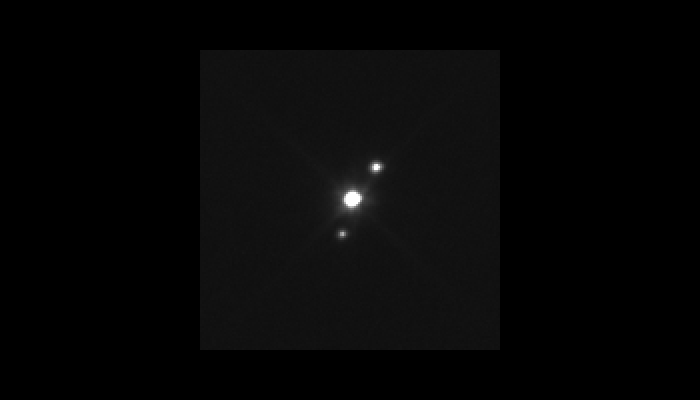(136108) Haumea is a dwarf planet in the subclass of Plutoids and is one of the largest known objects in the Kuiper Belt. Because of their rapid rotation and with an equatorial diameter of about 2200 km with a distance of the poles of only about 1100 km it has a greatly ellipsoidal shape. Haumea is running on an elliptical orbit in 285 years around the sun. The perihelion is 35 AU from the sun, the aphelion around 51 AU. The orbital plane is inclined 28° to the ecliptic.

Haumeaīs mass could be determined by the rotation of the larger of the two moons, with high reliability to 3.9 x 1021 kg, which corresponds to 30% of the mass of Pluto. From the observed light curve it can be concluded that the object rotates in only 3.9154 hours around its own axis. Haumea rotates faster than any other object in the solar system with a size of about 100 km. The observed light changes can also lead to the conclusion that the object has assumed an elliptical shape due to the rapid rotation: Its shape is believed to be a triaxial ellipsoid, which length is estimated to be about 2200 ą 200 km and its short axis only the half of this the size.
The rapid rotation of Haumea is explained by its formation by the collision of two dwarf planets. Accordingly, the original heavenly body is supposed to have a conflict with a 1000 km long object. A large part of the ice shell was blown away by the reaction, so Haumea has a significantly higher density than other Kuiper belt objects. From the fragments of the collision emerged not only the two moons, but also other smaller objects. These are forming together with Haumea an own family of celestial bodies.
Spectroscopic observations at Keck and the Gemini Observatory show traces of water ice on the surface of Haumea. Haumea was confirmed as a dwarf planet, although its deviation from a sphericity shape, most likely in a hydrostatic equilibrium.
Observations using adaptive optics at Keck Observatory have shown that Haumea is orbited by two moons. The larger of the two, Hi’iaka orbits at an average distance of 49,880 km in about 49.5 days around the dwarf planet. The smaller, Namaka, has a distance of 25,657 km and its orbital period is 18.3 days. In Hawaiian mythology Hi’iaka and Namaka are daughters of the fertility goddess Haumea, and they originated from different parts of the body Haumeas. The names of the moons refer to the supposed origin as fragments Haumeas after hitting another object.
| Discovery date | 2003 (J. L. Ortiz, F. J. Aceituno, P. Santos Sanz, M. Brown, C. Trujillo, D. Rabinowitz) |
| Semi-major axis | 6 478 634 956 km = 6.478 x 109 km (43.307 AU) Comparison: 43.307 x Earth |
| Perihelion | 5 251 184 432 km = 5.251 x 109 km (35.102 AU) Comparison: 35.102 x Earth |
| Aphelion | 7 706 085 479 km = 7.706 x 109 km (51.512 AU) Comparison: 51.512 x Earth |
| Diameter | 2200 ±200 km = 2.2 x 103 km Comparison: 0.1724 x Earth |
| Mass | 3 900 000 000 000 000 000 000 kg = 3.9 x 1021 kg Comparison: 0.00065 x Earth |
| Density | 2.6 – 3.3 g/cm3 Comparison: 0.471 – 0.598 x Earth |
| Sidereal rotation period | 0.163 Earth days 3.916 hours |
| Orbital period (Length of a year) |
285 Earth years 104 093 Earth days |
| Average orbital speed | 16 286 km/h = 4524 m/s Comparison: 0.1584 x Earth |
| Eccentricity | 0.189 Comparison: 11.3173 x Earth |
| Inclination | 28.194° |
| Minimum/Maximum surface temperature |
unknown Comparison: The temperature of the earth is ~ 185/331 K |
| Composition of the atmosphere |
unknown Comparison: The atmosphere of the earth is mainly composed of N2 and O2. |
Moons: